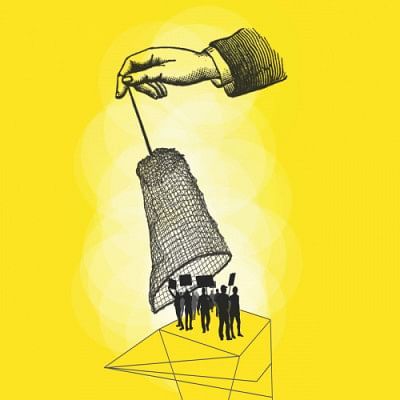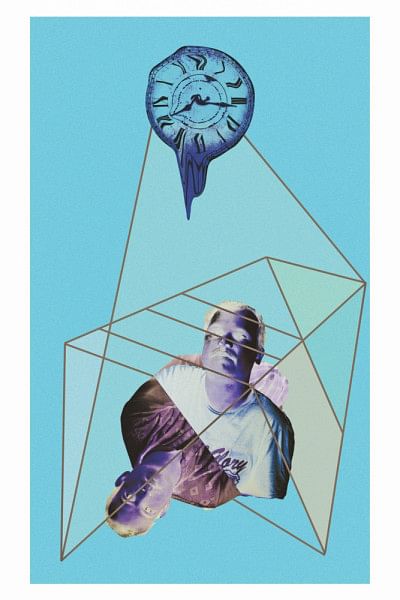When arrests warrant questions

"Where is your warrant?" is the first question that people ask when the police knocks on the door. That is the question being asked by a daughter in a video that recently went viral on Facebook, when the police came to apprehend her father. The police did not heed her plea and pushed right past in.
The same thing happened when the police arrested quota reform activist APM Suhel from the home of the former president of Bangladesh Students' Union Lucky Akhter on July 12. "The detective police came in the middle of the night and started banging on all the doors to create a commotion. We would not open the door at first because they did not have a warrant, so they got the landlord," says Lucky Akter. Akter was seeking the protection offered by a magistrate-issued piece of paper because having a warrant means the court, and not the police, are deciding the validity of the arrest.
The police, however, did not need an arrest warrant. Not many people know that under the law of Bangladesh, one doesn't exactly need to be a murderer to be arrested without a warrant. All one needs to do is commit what is known as a cognisable offence. Cognisable offences include an entire gamut of felonies ranging from grave offences like rape to things like "taking part in an unlawful assembly".
No warrant needed for demonstrators
In fact that is why all the quota reform activists could be picked up without a single arrest warrant—they were "taking part in an unlawful assembly".
Demonstrators Faruk Hasan, Sohel Islam, Rashed Khan, Toriqul Islam, Jashim Uddin Akash, and Moshiur Rahman have been booked under Section 149 of The Penal Code, a section that literally says that anyone who is present on spot while others are rioting can be held liable too.
To quote, "If an offence is committed by any member of an unlawful assembly in prosecution of the common object of that assembly, or such as the members of that assembly knew to be likely to be committed in prosecution of that object, every person who, at the time of the committing of that offence, is a member of the same assembly, is guilty of that offence."
In effect, that means every single person who has been present on spot demonstrating (which is perceived to be unlawful by the law enforcing agency), while the Dhaka University campus went berserk can be held liable, regardless of whether they burnt a single tire or threw rocks at the police. And demonstrators—demonstrating for any cause—can be arrested without a warrant, should the law enforcers deem the protest "unlawful".
But on what basis did the police decide that this particular assembly was "unlawful"?
Jyotirmoy Barua, a human rights lawyer, points out that it is important to determine the legality of police action against the demonstrators. "A policeman of the sub-inspector rank is present on spot, and as such, he decides whether or not the public demonstration is lawful. Yes, he receives instructions from higher officials but that is over the phone."
That the quota reform demonstrations have almost always ended in violence is a fact—and violence would automatically make a movement unlawful in the eyes of the law. But the media has stringently covered how student political wings swooped down on the demonstrations, starting the fight, and creating grounds for the police to intervene.
A video of Faruk Hasan being chased down and beaten up by whole group of alleged-Bangladesh Chhatra League (BCL) activists went viral on social media over the past two weeks, when the pro-ruling party student body foiled demonstrations at Shaheed Minar advocating quota reform. Faruk, reeling in pain on the ground, was being kicked and stomped mercilessly. A similar video of Toriqul Islam having his leg smashed with a hammer by a member of the BCL also went viral. There were no photographic or video evidence of quota reform activists assaulting any of the party men.
Besides, of the 19 people arrested so far in relation to the cases filed by the state following the quota demonstrations, there was not a single person belonging to BCL, the alleged perpetrators of the attack, for example. The law enforcers are simply using whatever authority has been given to them—but most of the arrestees so far have been from one side of the movement. Citizens across the spectrum are questioning the legality of arrests under these grounds without a warrant, because they believe that this hampers freedom of assembly and expression.
In fact, the first information report (FIR) filed following the demonstrations that happened on April 9 itself states, that the protests began peacefully but the police began the offensive, leading to it becoming violent.
"A large number of university students and others were protesting for a reform in the government's quota system in front of University of Dhaka's library […]. We asked the protestors to stop occupying the road because they were impeding traffic and there might be ambulances present. Instead of listening to us, they started crying out slogans even harder. That is when our higher officials instructed us to aim at them with a hot water cannon and fire from […]." The report includes a list of the weapons used to fire rubber bullets at them at that point.
The report goes on to say that in retaliation the protestors started attacking the police vehicles. That is when the police shot tear gas shells at them.
What the report filed by the police themselves makes clear is that they were the first to attack the procession—and that too at a point when the demonstrators were indeed peaceful and attack was started by the police.
And yet, all except two of the student leaders spearheading the movement are currently under arrest for "rioting" and "setting fire to things on the road".

Star Weekend asked several protestors if, and why, they were setting fire to things on the road.
"We were only setting fire to things because the tear gas was making us temporarily blind. Being close to a burning fire helps mitigate the effects of tear gas," describes a protestor, who is a graduate student of the Department of Theater and Performance Arts.
The other law that would give them rights
There is a dilemma regarding what legal rights the arrestees have. The police have produced the students as arrestees under the cases filed in April when the quota reform demonstrations were first underway. The charges in those cases, as has been discussed so far, require no warrant. (The only exception is Rashed Khan who was arrested under the Information and Communication Technology Act for going live on Facebook to talk about his views. This too requires no warrant.)
But Supreme Court lawyers Sara Hossain and Jyotirmoy Barua, who are currently representing the arrestees, say that they could not have been arrested without the application of Section 54 of The Code of Criminal Procedure, titled "When police may arrest without warrant". The lawyers argue that the police can only arrest someone under The Penal Code if a case has the name of the person in it, or they have reasonable suspicion.
For example, someone set fire to a motorbike belonging to an officer of the Special Branch of the police. As per documents collected by Star Weekend, the FIR filed when the case was opened in Shahbagh police station does not include quota reformist Faruk Hasan's name or any details describing him, but he was later on arrested for it. When the investigating officer inspector Bahauddin Faruki was asked whether anybody saw Hasan commit the crime, he declined to comment.
In fact, none of the cases filed following the protests included the names of the students as the accused. It was only months later that they were arrested without a warrant and booked under these cases.
Supreme Court lawyer Tanjib-ul Alam concurs with Hossain and Barua. "If the FIRs of the case mention 'unnamed' as the accused then the students would have had to be taken in under Section 54," he states.
Section 54 provides very clear guidelines on when and how these arrests can be made. This guideline provides the arrestee with some rights otherwise not afforded to them under other cognisable offences.
The catch is that the police are claiming that arrestees have not been arrested under Section 54 but under The Penal Code. Masudur Rahman, Deputy Commissioner (media) of Dhaka Metropolitan Police, says that they have evidence. "After the cases were filed in April we conducted investigations and found that these students were involved with the offences they were charged against, and so we arrested them," he says.
The students' lawyers, however, don't accept this argument. "These are essentially false cases. The arrests of the students were arbitrary. It was only after the fact that the police showed them arrested in old cases. When you have a case with no specific names, the police pick and choose whomever they want and book them under that charge. In my experience I have seen that all politically motivated cases are filed like this," says Barua.
If the police accepted that the students were arrested under Section 54, they would have had to give them certain rights.
The guideline for arresting under Section 54 mandates that an arrestee must also be allowed access to a lawyer and can only be interrogated in a room inside the prison with glass walls. Lawyers and relatives are allowed to observe the interrogation.
Barua, who argues that the arrests were made under Section 54, says, "I was not allowed to observe the interrogation when the students were taken into remand by the police."
Hossain too faced similar resistance from the police. "I went to see the students who were being kept in lockup at the Shahbagh police station, but I was not allowed in."
Other rights include notifying relatives about the arrest. Faruk's family too was not made aware of his arrest till the next day. "I checked the police stations at Shahbagh, Ramna, New Market and even the DB office but nobody could tell me anything about him," says Arif, the brother of Faruk.
Warrantless arrests made under Section 54 have another condition to fulfill: Why the police have reason to believe that the person must be arrested has to be logged in a case diary. The case diary must be maintained during the investigation—before the arrest. This case diary has to be submitted to court when the arrestee is produced before a magistrate. "No such case diary was submitted to the court in the cases of the quota reformists. I myself asked the magistrate in court why the case diary is not being handed in by the police and he said he did not know that this was a requirement as per the law," explains Barua.
Inspector Bahauddin Faruki, the investigating officer of the case, claims that he submitted the case diaries to the court. Barua and other lawyers dealing with the case however reiterate that no such evidence was handed in.
These rights were provided by a guideline crafted by the Supreme Court itself in a 2016 judgment following a writ petition filed by Bangladesh Legal Aid and Services Trust (BLAST) and others in 1998. They had petitioned to add these rights because Section 54 was otherwise being used to arbitrarily arrest anyone.
"These rights are given to arrestees taken in without a warrant so as to make the arrest constitutional," says Barua, "but that has not changed the use of warrantless arrests to unfairly target people."

 For all latest news, follow The Daily Star's Google News channel.
For all latest news, follow The Daily Star's Google News channel. 



Comments